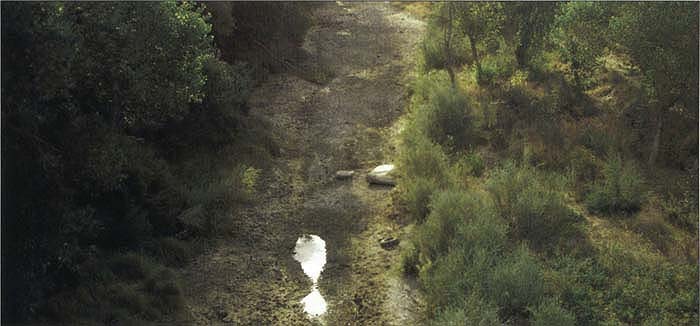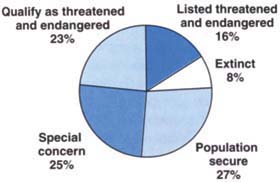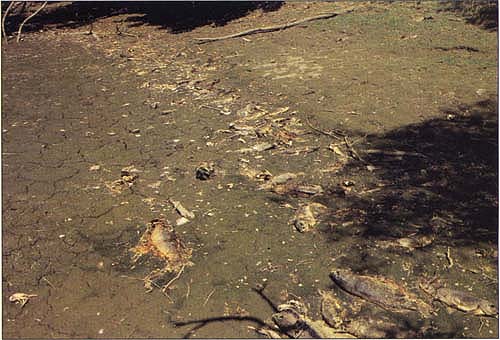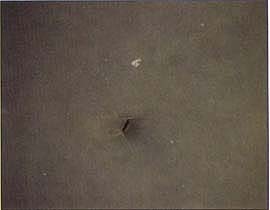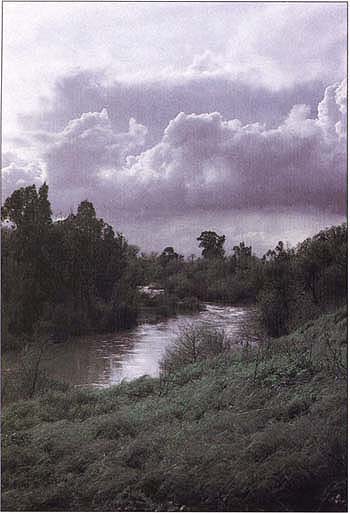All Issues
The case of Putah Creek: Conflicting values complicate stream protection
Publication Information
California Agriculture 49(6):73-78. https://doi.org/10.3733/ca.v049n06p73
Published November 01, 1995
PDF | Citation | Permissions
Abstract
Increasing human demands for water in California have led to a decline in the diversity and abundance of native aquatic organisms, including valuable salmon and steelhead. Declines worsen during drought years, a fact demonstrated in 1989 when lower Putah Creek dried out in the third year of the state's most recent drought. That year, the Putah Creek Council (a local environmental group), UC Davis and the City of Davis joined forces to purchase more water from the Solano Irrigation District, thereby saving the fish that had survived in a few isolated pools. Since then, these parties and numerous others have filed lawsuits to establish rights to the waters of Putah Creek. While legal questions about these water rights remain to be settled, the events surrounding Putah Creek underscore the need for communities and irrigation districts to develop long-term water policies that recognize environmental needs in the context of California's frequent droughts. Such problem-solving will depend on balancing the conflicting value systems of different groups of water users.
Full text
As Putah Creek dried out during a recent drought, the people of Davis bought water to save the surviving fish.
Water is California's most limiting resource: Much of the state is semi-arid and 20% of the land receives less than 5 inches of rain per year. Paradoxically, the state uses nearly a quarter of the water delivered to consumers annually in the United States. Water is essential to the cities, farms and industries that make California prosperous; to the lakes and streams that make the natural environment so attractive to humans; and to the rich variety of endemic aquatic species.
An average of 60% of California's total available water (34 million acrefeet delivered yearly) comes from surface flow and 40% is taken from groundwater. In 1985 California allocated 80% of this developed water supply to agriculture, 16% to urban areas and only 2% to wildlife and recreation, according to the California Department of Water Resources.
Because water is a limiting resource in California, it is subject to intense competition among users and all too often seems to be in short supply. As early as the 1890s, San Joaquin Valley farmers wrangled over water, often guarding their ditches from each other with shotguns. Today, the natural environment receives much less water than it did before the agricultural industry developed.
This fact has contributed to the dramatic decline of California's native fish. Of the 113 native fish taxa — species, subspecies and distinct runs of anadromous fish — more than 70% are either extinct, listed as endangered or in serious decline (fig. 1). (Some of this decline is also due to introductions of exotic game and nongame fish.) The declining fish include all of the state's anadromous species (those which migrate from the sea to breed in fresh water) such as Chinook salmon, coho salmon and steelhead trout, which are important to fisheries (see sidebar, p. 74 ). Increasing numbers of California's fishes are being listed or proposed for listing as endangered, intensifying water conflicts and often pitting fishermen and environmentalists against farmers and urban water developers.
These disputes reflect how values shift in society, as communities reevaluate the priorities they've assigned to water use. In some cases, society has favored allocating a greater share of California's water to environmental needs (see sidebar, p. 77 ). A case in point which has yet to be resolved is the dispute over the waters of lower Putah Creek, which flows through the UC Davis campus.
Putah Creek, a refuge
Putah Creek originates high in the Coast Range near Mt. Cobb in Lake County and winds its way east into Berryessa Reservoir. Lower Putah Creek (below Berryessa Reservoir) flows through approximately 30 miles of rich agricultural land in Yolo and Solano counties before terminating in the Yolo By-pass, a large flood-control channel that drains into the Sacramento River. While nearly every scrap of land around lower Putah Creek is cultivated or urbanized, the creek itself has a thin border of cottonwoods, sycamores, willows and other riparian plants.
The creek and its riparian vegetation are a refuge for wildlife that is otherwise rare or declining in the region including the giant garter snake, the valley elderberry longhorn beetle, the northwestern pond turtle and Swainson's hawk. During the spring and fall, the bushes along the creek are rich with migrating warblers and sparrows. Wood ducks raise their broods in the large, shaded pools of the creek.
Putah Creek also contains a large number of fish species. While the majority of these are introduced game fish, the creek still supports remnants of the once-abundant Central Valley native fish. Both these stream fish and the anadromous fish that historically spawned in the creek were a source of food for the Patwin Indians who lived in the region prior to 1850 where the UC Davis campus now stands.
Putah Creek changed dramatically in 1948 when the Secretary of the Interior authorized plans for the Solano Project. The impetus for the Solano Project was that Solano County felt its prosperity rested on an adequate and dependable source of water. The project's goal was to provide water to the newly created Solano Irrigation District (SID), which supplies the rich agricultural lands, as well as the military, industrial and urban area of Solano County. The project was also designed to provide a measure of flood control.
The Solano Project consists of two major parts: the main water-storage structures are Berryessa Reservoir and Monticello Dam, and the diversion structures that send water south to Fairfield and Vacaville (Solano Diversion Dam and the Putah South Canal).
Today water is collected behind Monticello Dam during the rainy season and is released down a 10-mile stretch of stream as needed to the Solano Diversion Dam. Water from the diversion dam is both transferred southward through the Putah South Canal and released downstream into lower Putah Creek according to a monthly schedule. The downstream release schedule is exactly the same every year, except in years of low rainfall (and low inflow into Berryessa Reservoir) when releases are reduced. During most years, the amount of water allocated for the lower creek is only about 10% of the water diverted down the Putah South Canal—although during periods of high rainfall—spills over the diversion dam can increase the downstream flows.
In addition to having reduced flows as the result of the diversion, the amount of water in lower Putah Creek has been reduced by groundwater pumping in the region. The combination disrupted the creek's natural hydrologic cycle. Historically, during the hottest summer months the lowest reaches of the creek often lost surface flow and isolated pools formed. However, groundwater provided these pools with substantial cool-water recharge, thereby maintaining the integrity of the entire native stream community.
Unfortunately, the current hydrological regime allows portions of the creek to dry completely during drought years that formerly supported pools and short stretches of surface flow. Notably, in the summer of 1989, which was the third consecutive year of the latest drought, most of the water released by the Solano Irrigation District was removed by the pumps of streamside farmers or sank into the streambed, replenishing groundwater.
As lower Putah Creek dried out, fish died in large numbers. Herons and egrets congregated along the shrinking pools, feasting themselves on stranded fish. Later that summer, most of the creek dried up. Miles of dry channel were littered with the decaying bodies of fish, crayfish and tadpoles, while hardy catfish struggled to survive as isolated pools became smaller and smaller. Eventually only a few large, deep pools remained.
The fish in these large pools were saved when the Putah Creek Council, a local environmental group, joined UC Davis and the City of Davis to purchase more water for the creek from the Solano County water agency. The water purchased was just enough to keep the pools from drying out or stagnating to the point where the fish would die.
Conflict continues
The wrangling over lower Putah Creek's water continues to this day and epitomizes the people-versusfish water-use conflicts throughout California.
Water disputes like that over Putah Creek and the seemingly intractable disagreements they pose are often the result of fundamentally different worldviews. Historically, many Californians have seen water largely as a resource to support mining, agriculture, urban development and other activities. This view is reflected in the names of California's principal water agencies: the Department of Water Resources and the Water Resources Control Board.
In this view, water is seen as a commodity to be bought and sold, and the emphasis is economic. For example, agriculture values water mainly for its role in producing crops to meet market demands and industry values water mainly for manufacturing and producing goods. The view of water as a commodity is implicit in terms such as “water rights” and “water uses.” When water is thought of this way, certain conclusions follow: water should be used to produce the greatest gain for the greatest number of people; water can be bought, sold, moved and partitioned; and water can be used as currency.
While this monetary interpretation of water is not fundamentally wrong, a number of alternative viewpoints extend water's value beyond economic considerations. One of these views is that water has value for maintaining natural ecological processes. To fully appreciate this view, it is necessary to examine the role water plays in natural ecosystems, especially aquatic and riparian systems. Fish and other aquatic organisms obviously require water because that is where they live. But the issue is more complex than simply providing aquatic organisms with adequate amounts of water. Other aspects of water are also essential such as the quality of the water and the yearly pattern of flows.
For example, the flows of Central Valley streams are highly variable from year to year because the amount of winter rain is irregular. However, in a given year the basic seasonal pattern of flow is fairly predictable: high flows occur in the late winter and early spring, and low flows occur in late summer and fall. The fish native to Central California evolved under these demanding hydrologic conditions and therefore are uniquely adapted to thrive there. These fish have fairly narrow spawning windows that are timed to the high flows created by rainfall or snowmelt. They also have fairly long lives so they can survive through dry years and spawn again during wet years.
When the flow regime is altered, especially when the spring flows needed for spawning are eliminated, the native fish tend to disappear and be replaced by fish such as carp and green sunfish that were introduced by humans for food or other reasons.
Besides being essential for aquatic organisms, water is necessary for riparian ecosystems. Water helps break down dead organic material, mediates the process of nutrient exchange in soils and is required for plant and animal growth. When most of the water is removed from aquatic and riparian ecosystems, they change dramatically and often disastrously. The evidence for this includes the dead riparian forests along streams in the Mono Basin from which the water was diverted, the sediment and erosion problems in the Trinity River watershed and the diminished fisheries of the Sacramento-San Joaquin estuary.
Water: alternative views
Water plays a vital role in California's environment. Community actions such as the 1989 purchase of water for drought-stricken Putah Creek indicate that some Californians now recognize the value of intact ecosystems. We rely on functional ecosystems for the continued health of our land, air and water, which in turn benefits human health and well-being.
A second alternative to viewing water as a commodity is to value streams and rivers for their educational potential. For example, lower Putah Creek is an important educational asset to UC Davis. Each year hundreds of students visit the creek on class field trips and to conduct research projects. UC Davis students from urban settings often receive their first introduction to wildlife along the banks of Putah Creek.
A third viewpoint is to value streams and rivers for their nonconsumptive recreation such as boating, swimming and wildlife viewing. Such activities are becoming increasingly popular. Recent U.S. Fish and Wildlife Service surveys have shown that adult Americans engage in nonconsumptive wildlife-related recreation twice as much as they participate in fishing and hunting. Maintaining Putah Creek as a living stream was so important to the Putah Creek Council, the City of Davis and the University that they were willing to pay for the additional water to keep the creek and its inhabitants alive, even though this water would not directly generate income.
A fourth viewpoint is to value streams and rivers for aesthetic reasons. People can value a stream and its surroundings simply for its beauty and charm. In a 1993 survey by Times-Mirror Magazines, two-thirds of Americans indicated that environmental protection is more important than economic development. Aesthetic values of the environment are increasingly of fundamental importance in the personal philosophies of many people.
Aesthetic values can include valuing qualities inherent to organisms and ecosystems as advocated by wildlife biologist Aldo Leopold. Some people express a profound respect for other creatures and intact watersheds, and they value encounters with native species and functioning ecosystems such as living creeks. They often want to have this experience available not only for themselves but for their children and grandchildren.
Contrasts in worldviews and conflicting values can block communication between parties involved in water disputes. At times, it appears that environmentalists and water resource advocates are speaking different languages. It is often as difficult for water resource advocates to be sympathetic to environmental concerns as it is for environmental advocates to appreciate the resource values of water. The dialogue breaks down and lawsuits result. For example, the fate of Putah Creek has been entangled in the legal system for close to 5 years. There is still no answer to the main question of how much water is needed downstream.
Resolving water conflicts like the Putah Creek dispute seems destined to be a protracted legal process. Whatever the specific outcome, if we as a society acknowledge the value of preserving natural environments, then we must develop better long-term policies for water allocation that take into account California's frequent droughts, which occur an average of 3 years in every 10.
Competition among water users will increase as population grows. The question of whether or not Putah Creek will survive and thrive as a living representative of our natural waters will have to be balanced with increasing public demands for more food, goods and space. In the end the solutions will come down to a question of balancing conflicting values.



